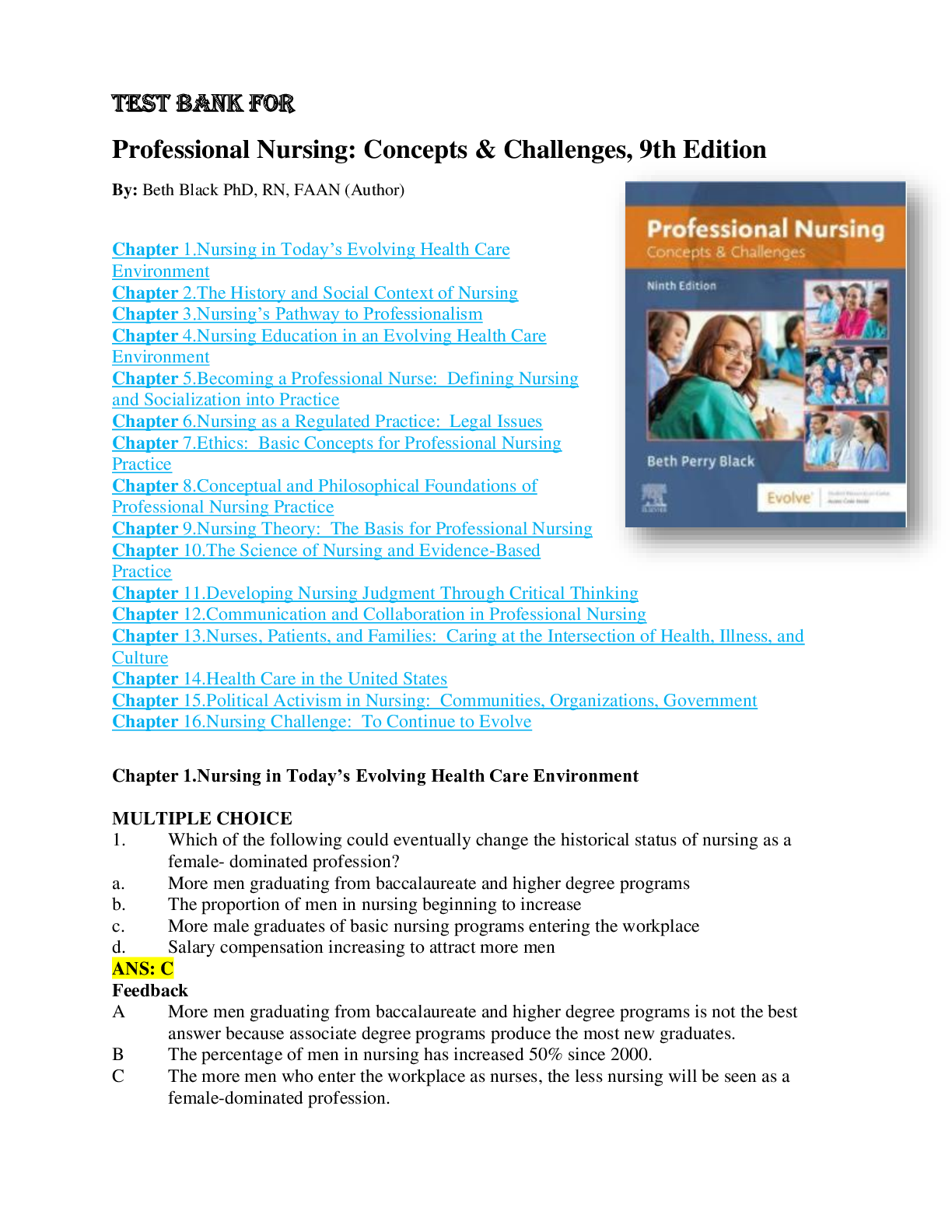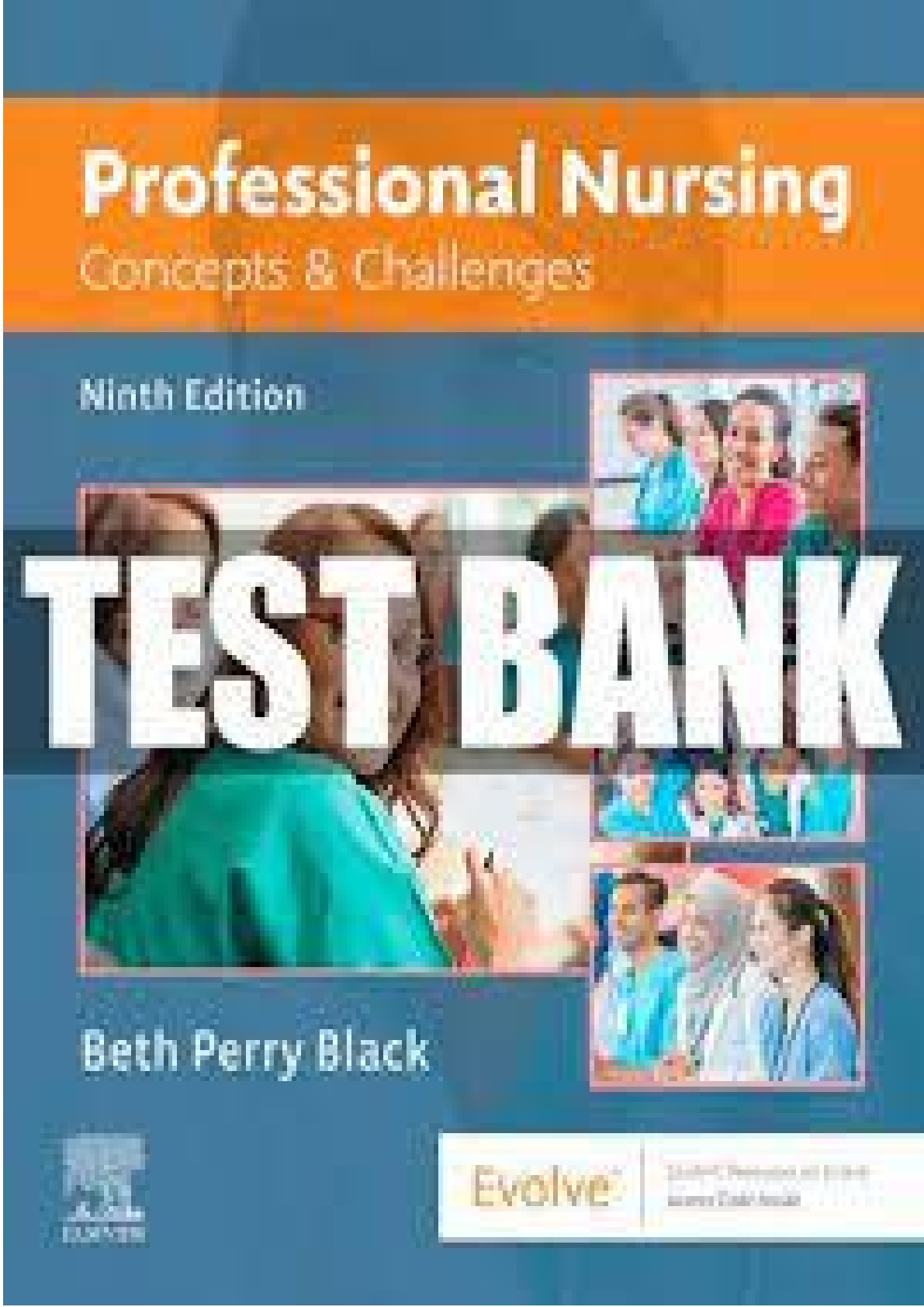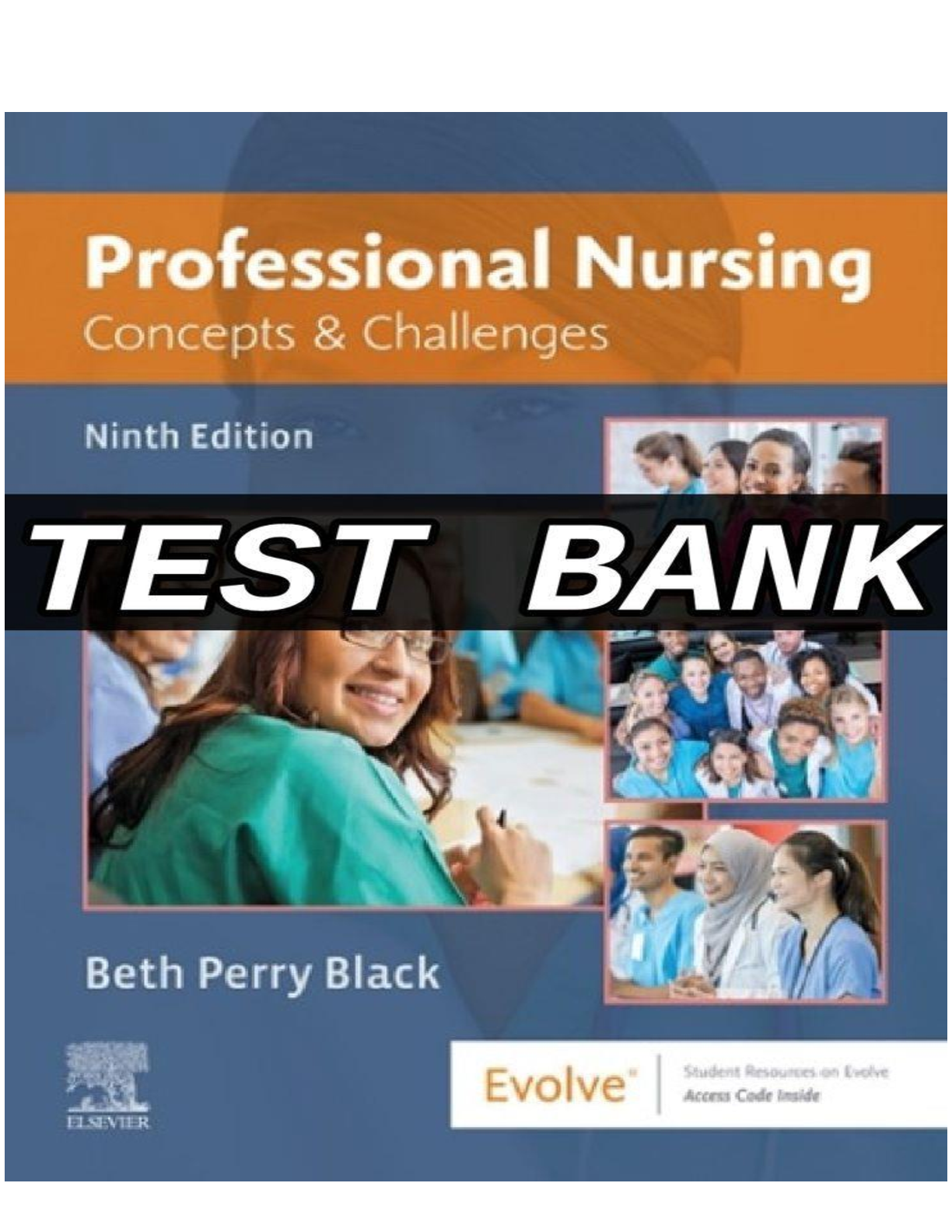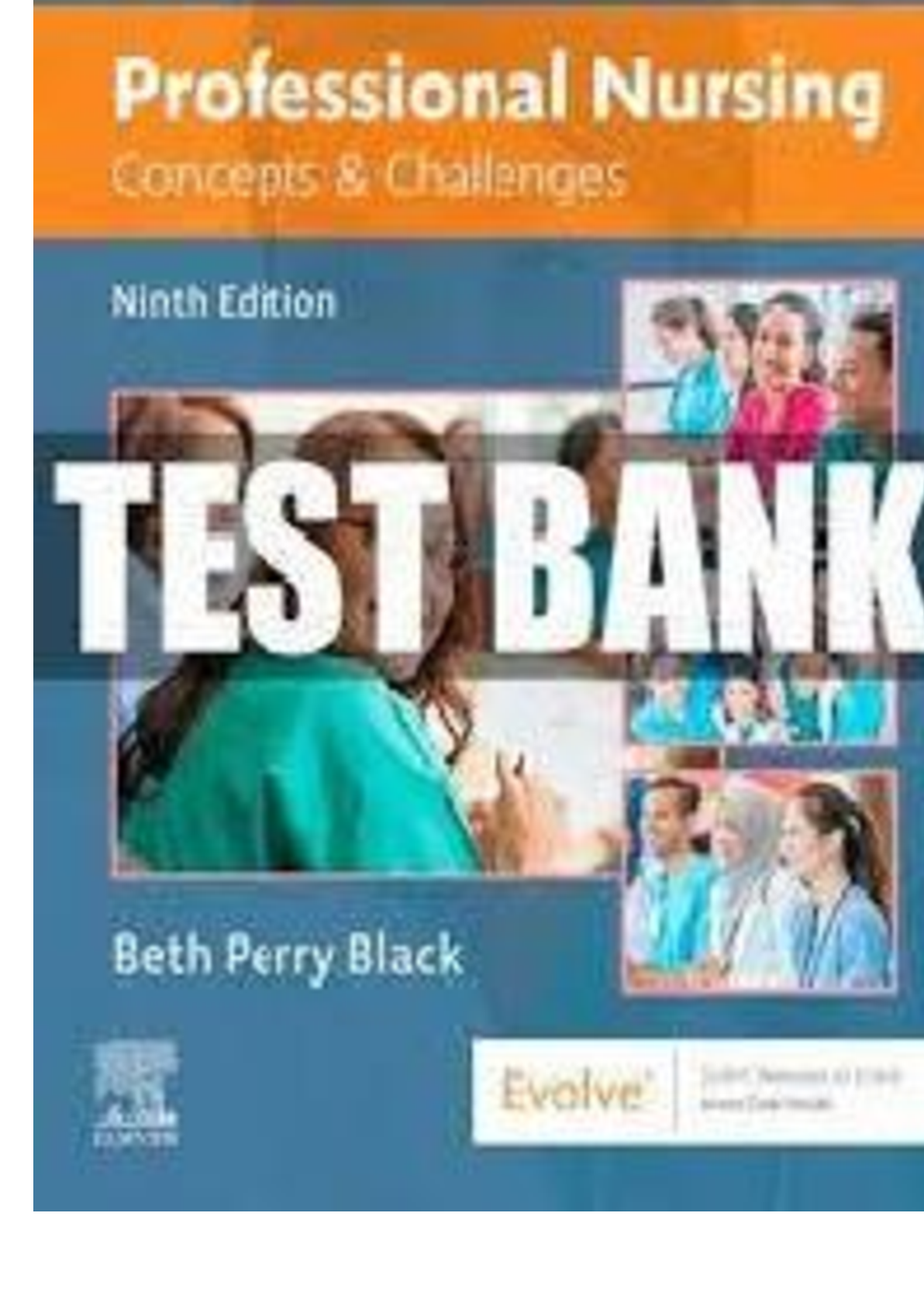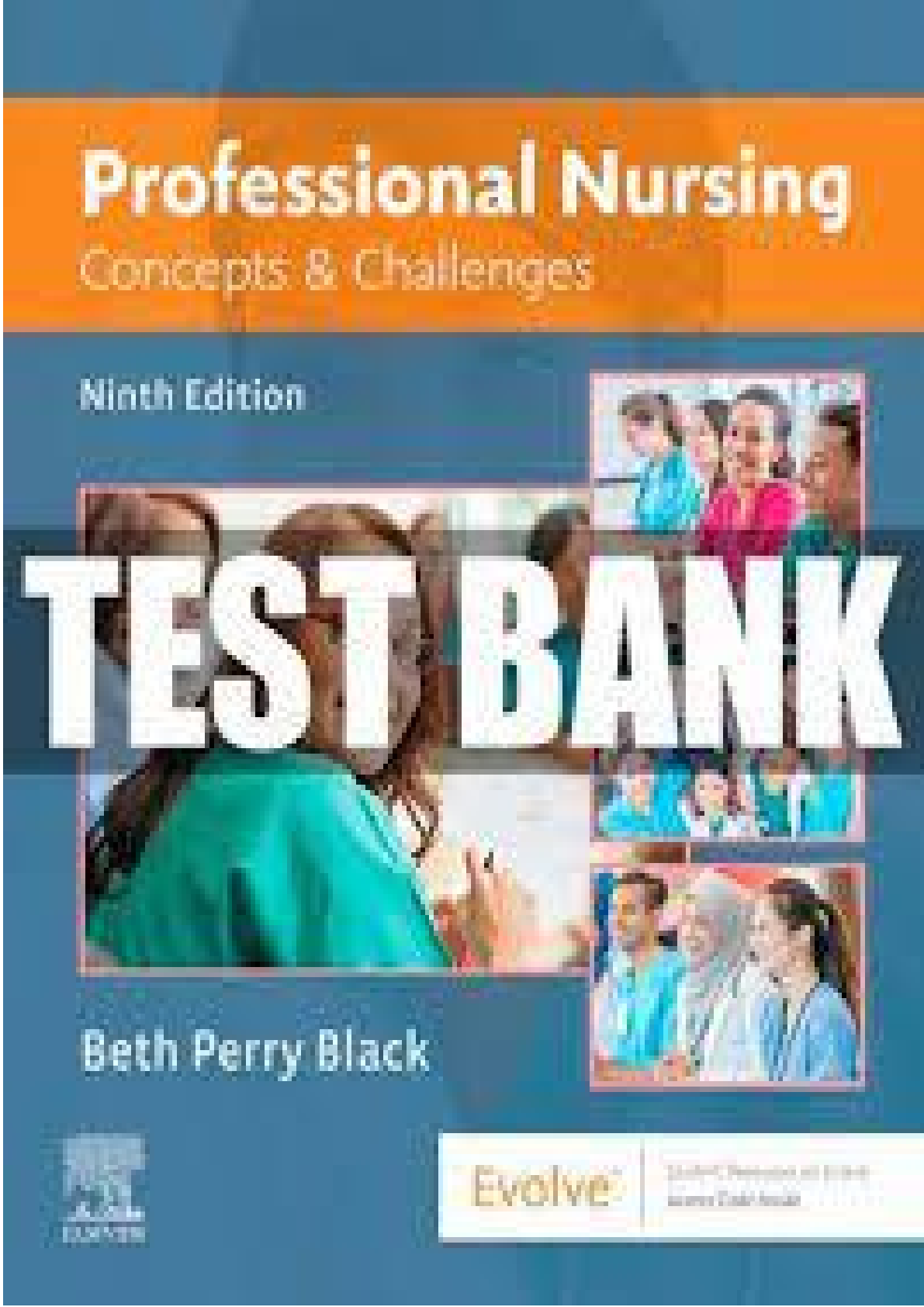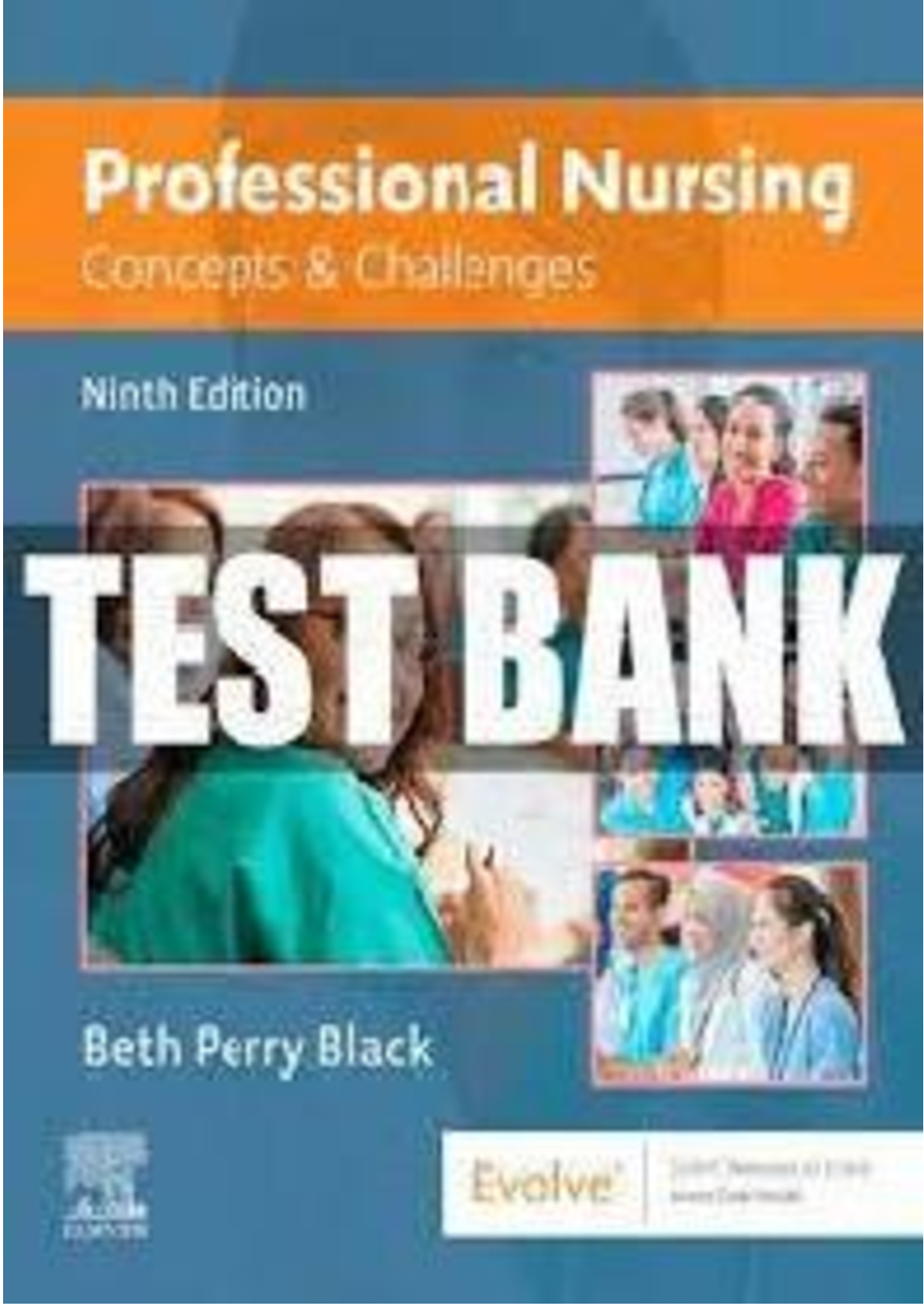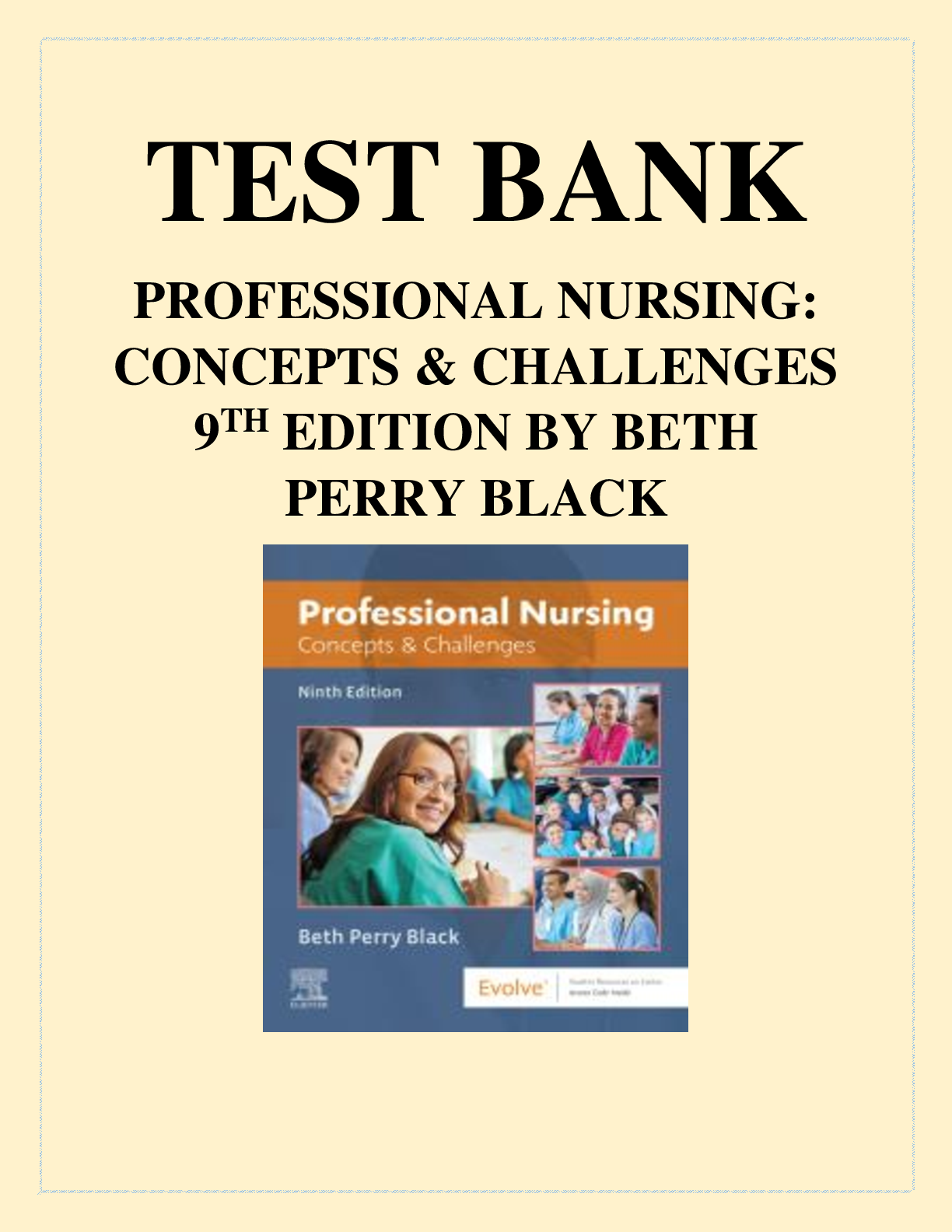Biology > TEST BANK > Test Bank Professional Nursing Concepts & Challenges, 9th Edition, Beth Black (All)
Test Bank Professional Nursing Concepts & Challenges, 9th Edition, Beth Black
Document Content and Description Below
Professional Nursing: Concepts & Challenges, 9th Edition Test Bank Chapter 1.Nursing in Today’s Evolving Health Care Environment MULTIPLE CHOICE 1. Which of the following could eventually change ... the historical status of nursing as a femaledominated profession? a. More men graduating from baccalaureate and higher degree programs b. The proportion of men in nursing beginning to increase c. More male graduates of basic nursing programs entering the workplace d. Salary compensation increasing to attract more men ANS: C Feedback A More men graduating from baccalaureate and higher degree programs is not the best answer because associate degree programs produce the most new graduates. B The percentage of men in nursing has increased 50% since 2000. C The more men who enter the workplace as nurses, the less nursing will be seen as a female-dominated profession. D Salary rates do not appear to relate to the recruitment of men into nursing. DIF: Cognitive Level: Comprehension REF: MCS: 2 2. The racial and ethnic composition of the nursing profession will change to more accurately reflect the population as a whole when a. the increased numbers of racial and ethnic minorities enrolled in educational programs graduate and begin to practice. b. the number of Asians or Native Hawaiian-Pacific Islanders begins to increase. c. the percentage of African-American and Hispanic nurses decreases more than the percentage of white nurses. www.testbanktank.com TEST BANK FOR PROFESSIONAL NURSING: CONCEPTS AND CHALLENGES, 9TH EDITION d. the nonwhite portion of the general population decreases. ANS: A Feedback A A larger percentage of minorities are enrolled in nursing educational programs than previously. B Asians and Native Hawaiian-Pacific Islanders are over represented in nursing compared to their percentage of the general population. C Not only would the percentage of African-American and Hispanic nurses need to increase, the percentage of white nurses would have to decrease in order to more accurately reflect the population as a whole. D The nonwhite portion of the general population is not likely to decrease. DIF: Cognitive Level: Comprehension REF: MCS: 3 3. Which of the following is a correct statement about the registered nurse (RN) population? a. The racial/ethnic composition of RNs closely resembles that of the general population. b. The number of men entering nursing has decreased steadily over the last decade. c. The rate of aging of RNs has slowed for the first time in the past 30 years. d. The majority of employed RNs working full time must work a second position. ANS: C Feedback A The racial/ethnic composition of RNs is increasing, but does not approximate their percentage of the overall population. B The number of men entering nursing is increasing. C The average age of RNs in both 2004 and 2008 was 46. This is a result of the numbers of RNs under 30 in the workforce. D According to 2008 data, only 12% of nurses working full time hold second positions. www.testbanktank.com DIF: Cognitive Level: Knowledge REF: MCS: 3 4. Which of the following best describes trends in nursing education? a. Numbers of RNs with bachelors and higher degrees are increasing. b. Numbers of RNs with associate degrees are decreasing. c. Foreign-born nurses practicing in the United States are seen as less knowledgeable because of their lesser educational preparation. d. Numbers of RNs with diploma educations are increasing. ANS: A Feedback A Slightly over 50% of RNs eventually obtain their bachelors of science in nursing (BSN) or a higher nursing degree. B The majority of nurses in this country get their initial nursing education in associate degree in nursing (ADN) programs. C Foreign-born nurses practicing in the United States may be viewed as less knowledgeable by their peers because of language and cultural differences. D The numbers of diploma-educated nurses are declining. DIF: Cognitive Level: Knowledge REF: MCS: 4 5. Despite the variety of work settings available to the RN, data from 2008 indicate that the primary work site for RNs is a. ambulatory care settings. b. community health settings. c. long-term care facilities. d. acute care hospitals. ANS: D Feedback www.testbanktank.com A Ambulatory care settings account for about 10.5% of RNs places of employment. B Public health and community health settings account for 7.8% of employed RNs. C Long-term care facilities account for 5.3% of RNs places of employment. D Statistics show that 62.2% of RNs work in acute care hospitals. DIF: Cognitive Level: Knowledge REF: MCS: 5 6. One important advantage of clinical ladder programs for hospital-based RNs is that they a. allow career advancement for nurses who choose to remain at the bedside. b. encourage nurses to move into management positions in which they can influence patient care on a broader scale. c. encourage RNs to become politically active and guide the profession of nursing. d. provide training to staff nurses so they can move seamlessly across departments. ANS: A Feedback A Clinical ladder programs allow nurses to advance professionally while remaining at the bedside. B Clinical ladder programs are designed to keep proficient nurses at the bedside. C Encouraging RNs to become politically active and guide the profession of nursing is not the goal of clinical ladder programs. D Clinical ladder programs are not designed to facilitate transfer between departments. DIF: Cognitive Level: Comprehension REF: MCS: 7 7. Which of the following statements is correct about community health nursing (CHN)? a. Prevention and community education are the cornerstones of CHN. b. Nursing care is rapidly moving from the home setting to the institutional setting. c. High-tech care such as ventilators and total parenteral nutrition cannot be handled in the home. www.testbanktank.com d. Assessment skills are less important in CHN because patients are not acutely ill. ANS: A Feedback A The community health nurse provides educational programs in health maintenance, disease prevention, nutrition, and child care. B Care is moving into the home setting. C Home care is increasing in complexity. D Community health nurses must have excellent assessment skills as they do not have the immediate backup that an acute care facility offers. DIF: Cognitive Level: Comprehension REF: MCS: 9 8. Which of the following is most essential for the nurse entrepreneur to be successful? a. Ability to take direction well b. Excellent time-management skills c. Avoidance of risks d. A college degree in business ANS: B Feedback A Nurse entrepreneurs must function autonomously. B Nurse entrepreneurs must be well organized and efficient. C Starting a business involves risk. D A degree in business is not required to be a nurse entrepreneur. DIF: Cognitive Level: Analysis REF: MCS: 10 9. The major benefit of serving as a military nurse is a. broader responsibilities and scope of practice than civilian nurses. www.testbanktank.com b. working with entirely baccalaureate-prepared peers on active duty. c. serving as an officer on active duty or in the reserves. d. the financial support to seek advanced degrees ANS: D Feedback A Although military nurses do have broader responsibilities and scopes of practice than civilian nurses do, this is not the major benefit. B Although military nurses do work with entirely baccalaureate-prepared peers on active duty, this is not the major benefit. C Although military nurses serve as officers on active duty or in the reserves, this is not the major benefit. D Advanced education is supported by the military financially and also allows for promotion in rank at an accelerated pace. DIF: Cognitive Level: Comprehension REF: MCS: 13 10. Which of the following statements explains why the school nurse of today is truly a community health nurse? a. The school nurse may be called on to care for a students family members in underserved areas. b. The school nurses primary responsibility is centered on the well child. c. The school nurses primary responsibility is to maintain immunization records. d. The school nurse must be certified in CHN. ANS: A Feedback A In medically underserved areas a school nurse may be called on to care for members of a childs immediate family. B Chronically ill, disabled, and physically challenged students are in regular classrooms. www.testbanktank.com C School nurses detect developmental problems; counsel and educate children, parents, and teachers; and maintain immunization records. D Although school nurses are considered community health nurses, certification in community health is not required. DIF: Cognitive Level: Comprehension REF: MCS: 13 11. What has been found about the outcomes of patients cared for in hospitals with a higher percentage of BSN-prepared nurses as compared to patients in hospitals with a lower percentage of BSN-prepared nurses? a. Patient outcomes are more dependent on nurse-patient ratios. b. Outcomes were better in hospitals with more BSN-prepared nurses. c. Outcomes were similar in both types of hospitals. d. Medical patients had better outcomes, but surgical patients fared the same. ANS: B Feedback A Nurse-patient ratio is an important determinant of patient care outcomes but has not been shown to be more or less important that the percentage of BSN-prepared nurses providing direct patient care. B Research by Aiken, et al, (2003) showed that patient outcomes were better in hospitals where higher percentages of BSN-prepared nurses were employed. C Research by Aiken, et al, (2003) showed that patient outcomes were better in hospitals where higher percentages of BSN-prepared nurses were employed. D Aiken, et al (2003) studied orthopedic, general surgical, and vascular surgery patients and found the outcomes were improved for these patients in hospitals with a higher percentage of BSN-prepared nurses. DIF: Cognitive Level: Knowledge REF: MCS: 7 12. Faith community nursing (FCN) was founded on which of the following premises? a. Nurses faith beliefs do not play a part in healing. b. The spiritual aspect takes precedence over the physical body in healing. www.testbanktank.com c. Spiritual health is central to a persons well-being. d. Faith community nurses must receive formal training as a minister or clergy. ANS: C Feedback A The nurses spiritual journey is believed to be an essential aspect of this nursing role. B Patients are treated holistically under FCN. C FCN is based on the belief that spiritual health is central to well-being. D Faith community nurses do not need to have formal training as a ministers. DIF: Cognitive Level: Comprehension REF: MCS: 16 13. One important advantage of the evolution of nursing informatics is that a. it allows any RN to become a certified informatics nurse. b. informatics nurses are best able to design systems with the needs and skills of nurses who use them. c. informatics nurses will reduce the need for direct caregivers to document care. d. benefits of informatics advancements include improved patient safety and increased variability of care. ANS: B Feedback A Although all nurses may use informatics, a nurse specializing in informatics should have a BSN and additional knowledge and experience in the field of informatics. B Informatics nurses understand how the information needs to be used and how to make the systems work for the nurses. C Direct caregivers will still need to document the care provided. D Benefits do include improved patient safety, but decreased variability of care is expected with informatics systems. www.testbanktank.com DIF: Cognitive Level: Comprehension REF: MCS: 17 14. Which of the following nursing roles is not considered an advanced practice role? a. Certified nurse-midwife (CNM) b. Community health nurse c. Certified nurse practitioner (CNP) d. Clinical nurse specialist (CNS) ANS: B Feedback A A CNM is an advanced practice role. B The community health nurse is not an advanced practice role. C CNP is an advanced practice role. D CNS is an advanced practice role. DIF: Cognitive Level: Comprehension REF: MCS: 17 15. NPs are advanced practice nurses who a. are required to have physician collaboration or supervision. b. function under a set of universal advanced practitioner laws. c. cannot receive direct reimbursement for their services. d. can diagnose and treat common and chronic conditions. ANS: D Feedback A The laws governing the practice of NPs vary from state to state, including the degree of supervision required and how they may be reimbursed for their services. www.testbanktank.com B The laws governing the practice of NPs vary from state to state, including the degree of supervision required and how they may be reimbursed for their services. C The laws governing the practice of NPs vary from state to state, including the degree of supervision required and how they may be reimbursed for their services. D NPs are prepared to handle a wide range of basic health problems. DIF: Cognitive Level: Comprehension REF: MCS: 18 16. The clinical nurse leader (CNL) is a recently proposed role. The responsibilities of the person in this role include which of the following? a. Oversee and manage care delivery in specific settings. b. Manage and streamline operations in multiple nursing units. c. Replace the outdated CNS role. d. Provide daily care to a specific subset of patients with similar needs. ANS: A Feedback A The CNL role is intended to provide the highest quality of nursing care by having masters-prepared nurses involved in the care of a distinct group of patients. B The CNL role was not intended as a managerial or administrative role. C The CNS role is not outdated, and some controversy exists because some CNSs view this new role as possibly disenfranchising them. D CNLs may on occasion provide direct patient care, but not on a daily basis. DIF: Cognitive Level: Knowledge REF: MCS: 20 MULTIPLE RESPONSE 1. Hospice and palliative care nursing is a rapidly developing specialty in nursing. Which facts have contributed to this growth? (Select all that apply.) www.testbanktank.com a. End-of-life care is largely the responsibility of nurses. b. End-of-life needs are expected to increase with the aging population. c. Nursing curricula have prepared nurses to deal effectively with dying patients and their families. d. Palliative care is a new focus of advanced practice nurses. e. Hospice and palliative care nurses work in a variety of settings. ANS: A, B, E Feedback Correct End-of-life care is largely the responsibility of nurses is correct because palliative care reflects the holistic philosophy of nursing, and comfort and relief have always been nursing responsibilities. End-of-life needs are expected to increase with the aging population is correct because as the population ages there will be a greater demand for end-of-life care as the number of individuals needing care increases. Hospice and palliative care nurses work in a variety of settings is correct because palliative care takes place in hospitals, homes, hospices, skilled nursing homes, etc. Incorrect Nursing curricula have prepared nurses to deal effectively with dying patients and their families is incorrect because nursing educational programs have not prepared nurses well as the content related to end-oflife issues and palliative care has been limited. Palliative care is a new focus of advanced practice nurses is incorrect because palliative care has been a focus of many nurses, not just advanced practice nurses. DIF: Cognitive Level: Comprehension REF: pp. 14-15 2. CNSs may (Select all that apply.) a. manage an inpatient nursing unit. b. develop educational programs for nursing staff. c. conduct practice outcomes research. d. prescribe medications for common illnesses. e. attend or assist in the delivery of low-risk newborns. ANS: A, B, C www.testbanktank.com Feedback Correct CNSs are prepared with an advanced nursing degree and the skills to function in a variety of settings and functional roles. Incorrect CNSs do not have prescribing authority. CNMs attend or assist at the delivery of low-risk newborns. Chapter 2.The History and Social Context of Nursing MULTIPLE CHOICE 1. Which early nursing leader founded the first training school for nurses that would later become a model for early nursing education? a. Dorothea Dix b. Florence Nightingale c. Clara Barton d. Mary Ann Bickerdyke ANS: B Feedback A Dorothea Dix is best known as an advocate for the mentally ill, and she created a brief training program at two New York hospitals for women who wished to serve as nurses in the Civil War. B Florence Nightingale founded the first training school for nurses at St. Thomass Hospital in London in 1806. This became the model for nursing education in the United States. C Clara Barton is known for founding the American Red Cross. D Mary Ann Bickerdyke is best known for nursing services during the Civil War. DIF: Cognitive Level: Knowledge REF: MCS: 25 2. Who was the first educated African-American professional nurse? a. Linda Richards www.testbanktank.com b. Phoebe Pember c. Sojourner Truth d. Mary Eliza Mahoney ANS: D Feedback A Linda Richards was the first trained nurse in the United States. B Phoebe Pember was one of the first women placed in charge of a hospital. C Sojourner Truth was a famous abolitionist who served as a nurse for the Union forces in the Civil War. D Mary Eliza Mahoney was the first African-American professional nurse; she was educated at the New England Hospital for Women and Children. DIF: Cognitive Level: Knowledge REF: MCS: 27 3. To which early nursing leader is attributed the founding of the American Red Cross? a. Clara Barton b. Dorothea Dix c. Florence Nightingale d. Lavinia Lloyd Dock ANS: A Feedback A Founding the American Red Cross is attributed to Clara Barton. B Dorothea Dix was superintendent of women nurses of the Union Army. C Florence Nightingale was an English pioneer in nursing. D Lavinia Lloyd Dock was influential in forming the National League for Nursing (NLN). DIF: Cognitive Level: Knowledge REF: MCS: 26 www.testbanktank.com 4. What were some of the application requirements of nursing education programs in the 1900s? a. Male, intelligent, strong b. Female, sensitive, subservient c. Female, docile, from poor background d. Male, high breeding, independent ANS: B Feedback A Men were not thought to be sensitive enough for nursing. B Sensitivity, breeding, intelligence, ladylike behavior, and submission to authority were highly desired personal traits for nursing students. C High breeding was desirable for nursing education program applicants. D Men were not desired nursing education program applicants. DIF: Cognitive Level: Knowledge REF: MCS: 27 5. Which of the following statements best describes how the Chicago Worlds Fair of 1893 became a pivotal point in the history of nursing education in the United States? a. Florence Nightingales work on sanitation and its relationship to mortality rates was finally recognized. b. The organization today known as the NLN was formed to address issues in nursing education. c. The American Nurses Association (ANA) was formed to oversee nursing education in the United States. d. The International Council of Nurses (ICN) was formed to enhance collaboration between practicing nurses and educators. ANS: B Feedback A Florence Nightingales paper was on scientific training of nurses. www.testbanktank.com B Several influential nursing leaders met at the Chicago Worlds Fair and started the National League for Nursing Educationthe precursor to the NLN. C The NLN, not the ANA, was formed to oversee nursing education in the United States. D The ICN was not founded until 1899 and is not involved in U.S. education of nurses. DIF: Cognitive Level: Comprehension REF: MCS: 28 6. Which early nursing organization is credited with first recommending state registration for nurses? a. ICN b. NLN c. ANA d. National Association of Colored Graduate Nurses ANS: A Feedback A The ICN was formed to unite all nursing organizations. The topic of the first meeting was registration for nurses by each country and state. B The NLN was formed to oversee nursing education in the United States. C The ANA was formed to enhance collaboration between practicing nurses and educators. D The National Association of Colored Graduate Nurses was formed to develop leadership among African-American nurses. DIF: Cognitive Level: Knowledge REF: MCS: 28 [Show More]
Last updated: 11 months ago
Preview 1 out of 261 pages
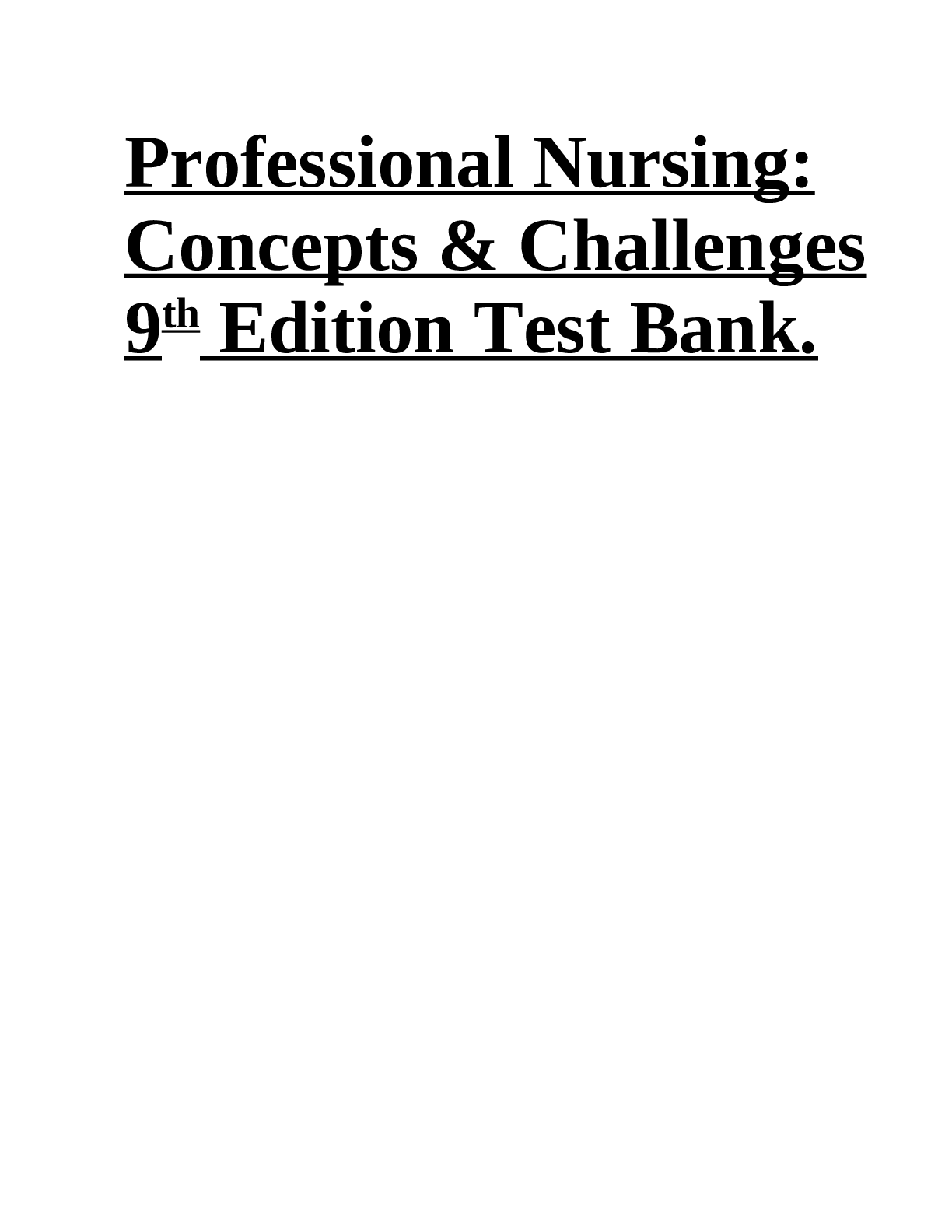
Reviews( 0 )
Document information
Connected school, study & course
About the document
Uploaded On
May 14, 2022
Number of pages
261
Written in
Additional information
This document has been written for:
Uploaded
May 14, 2022
Downloads
0
Views
31


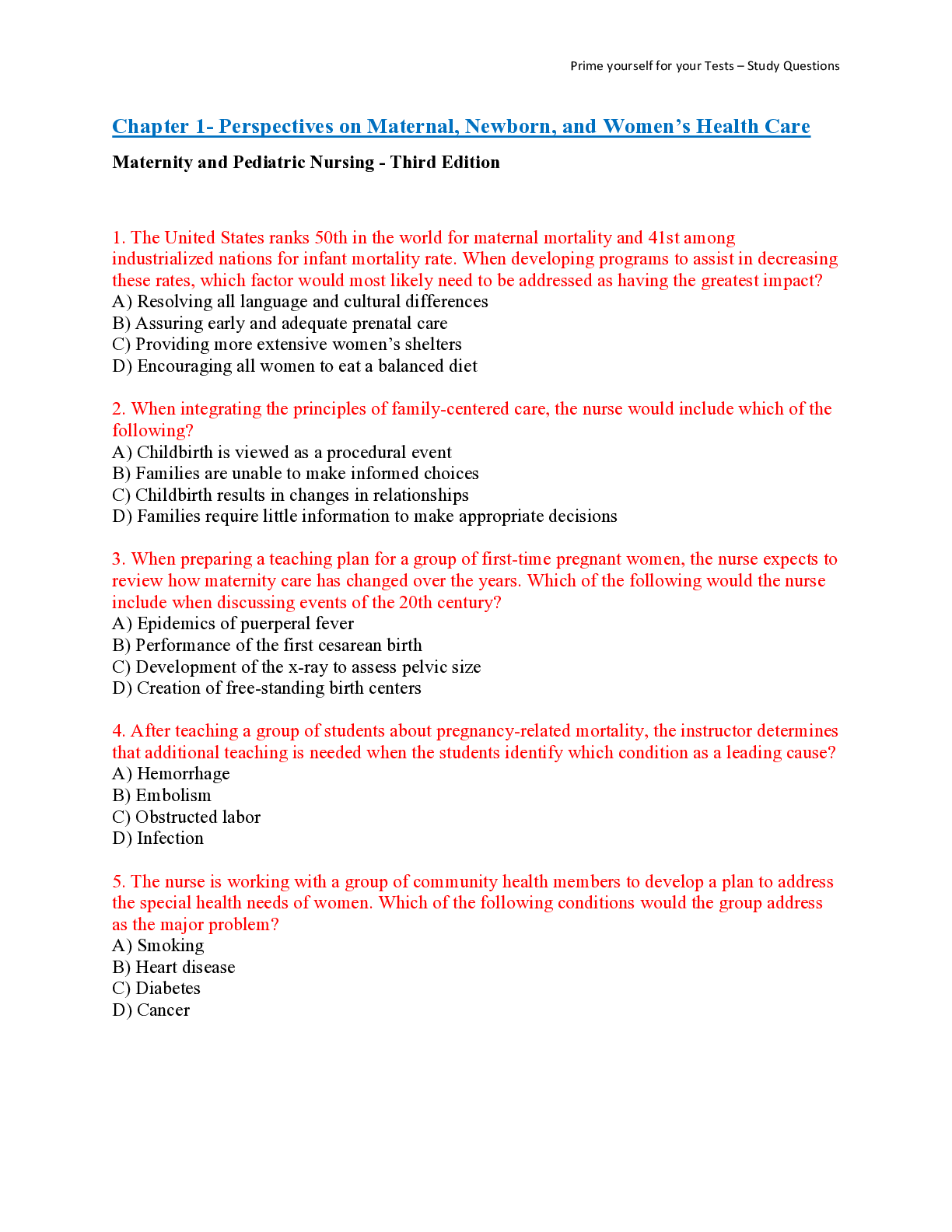
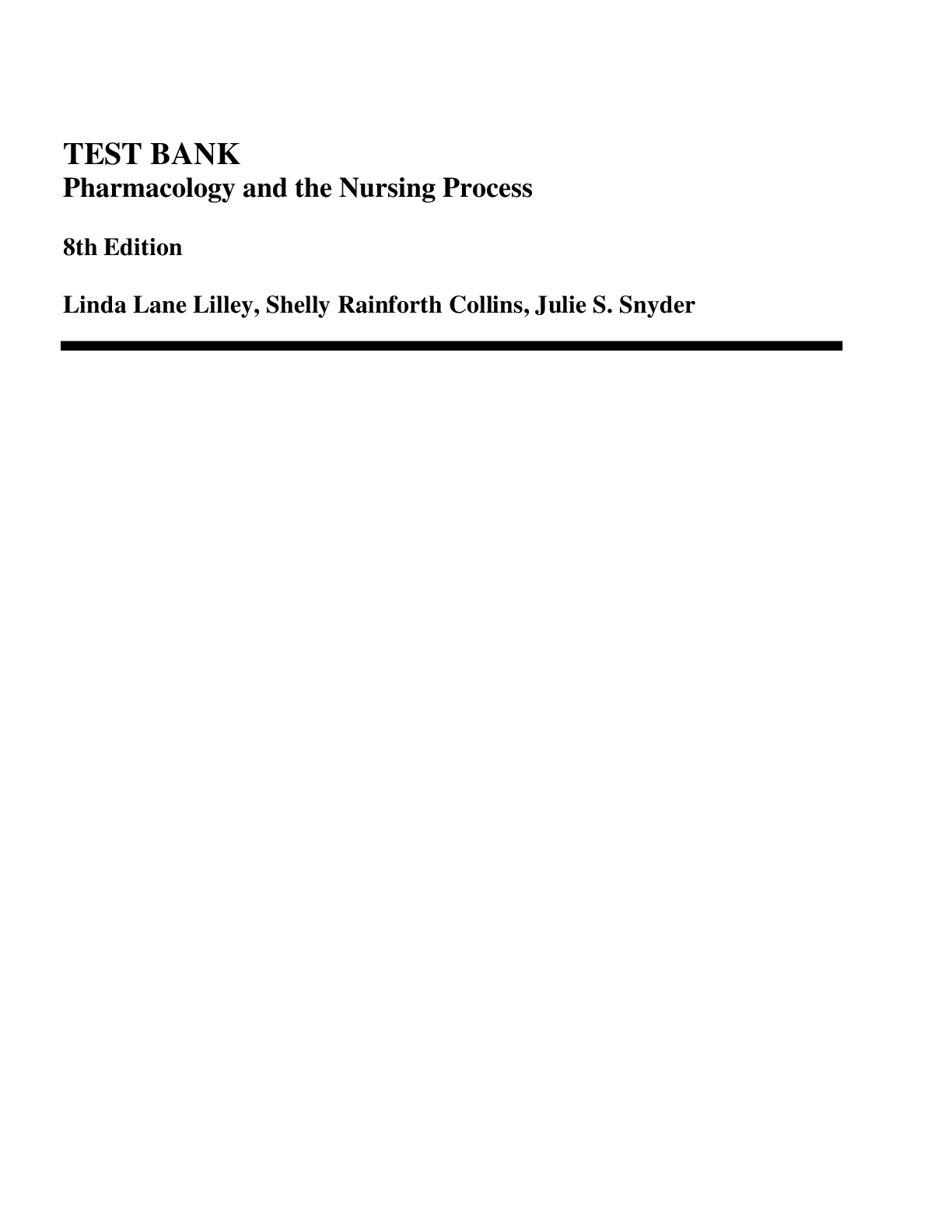
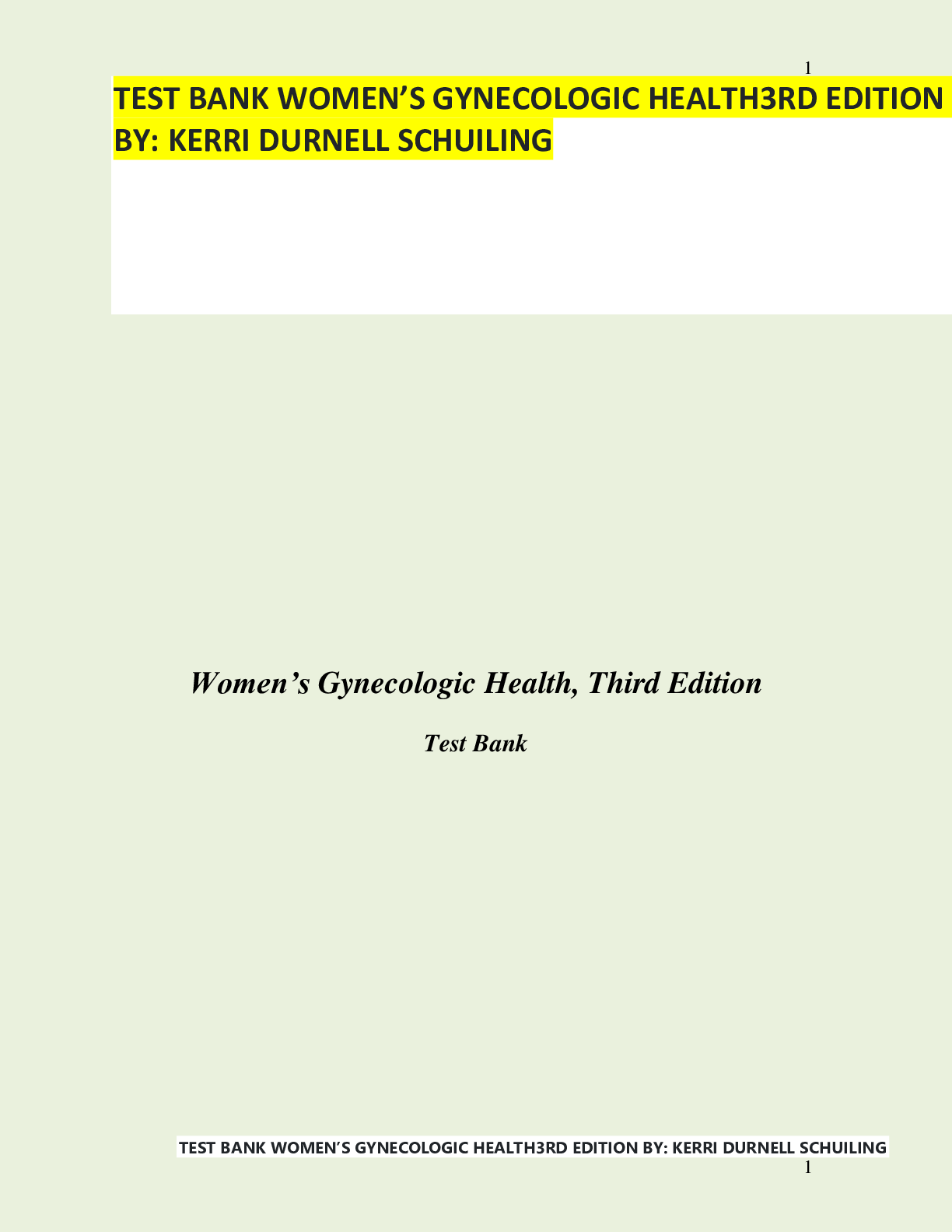
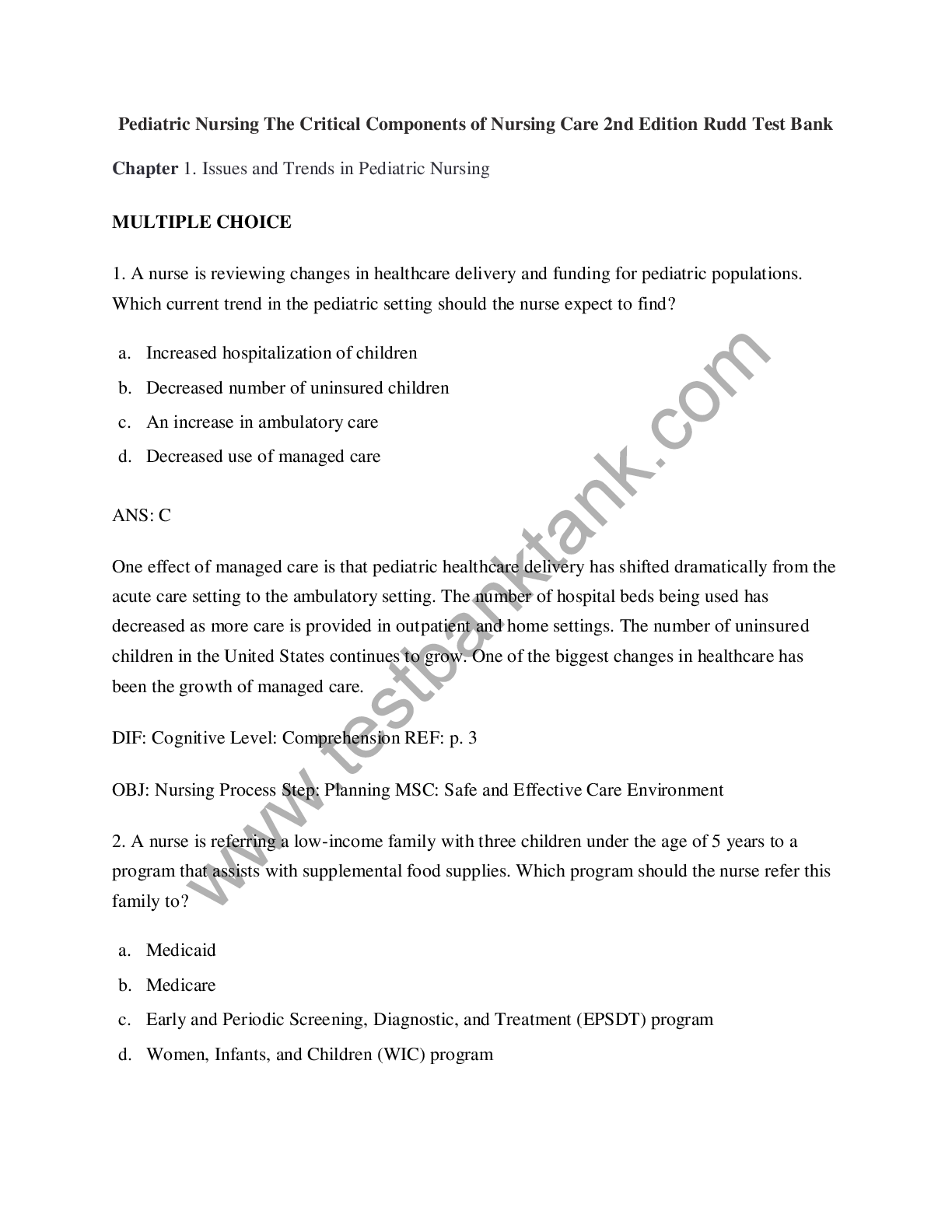
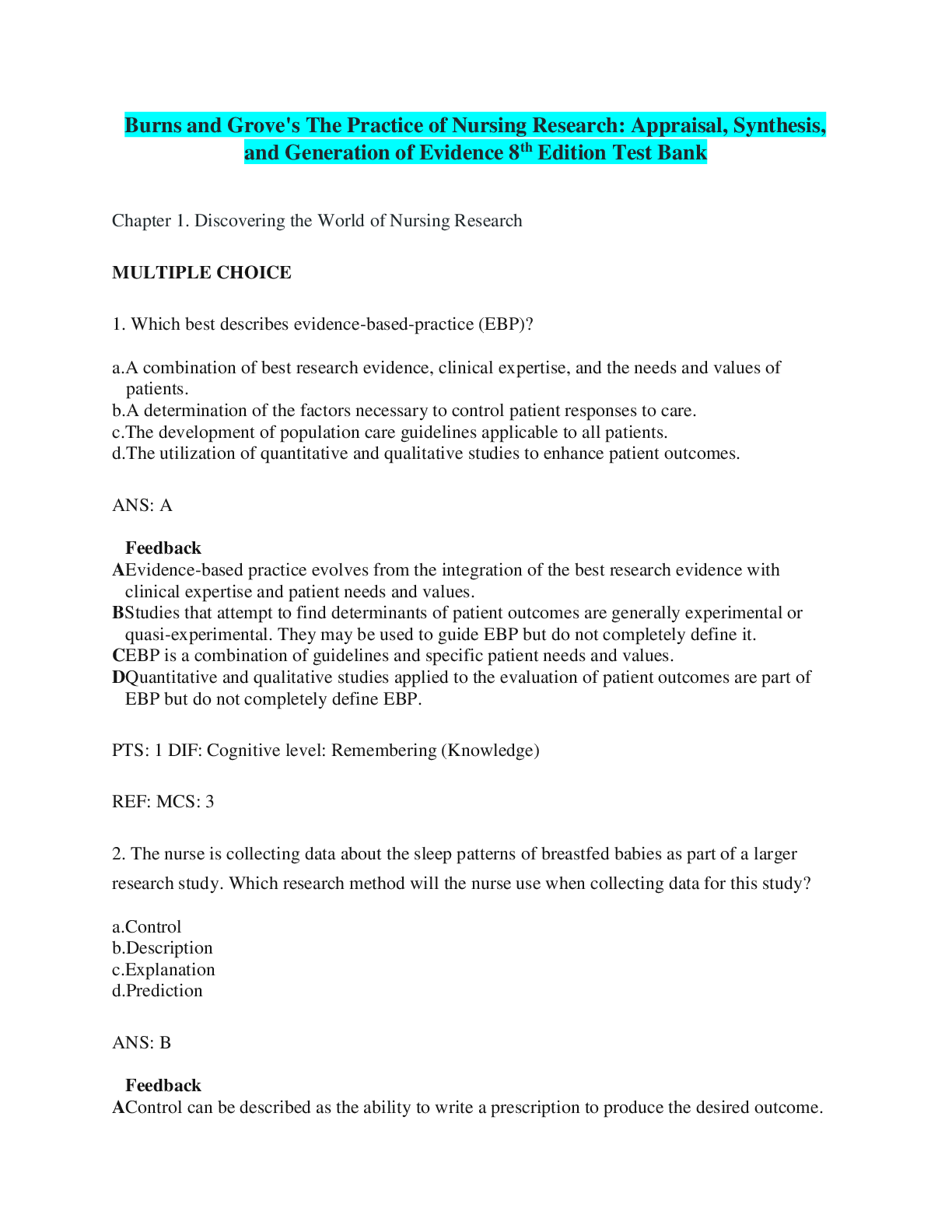
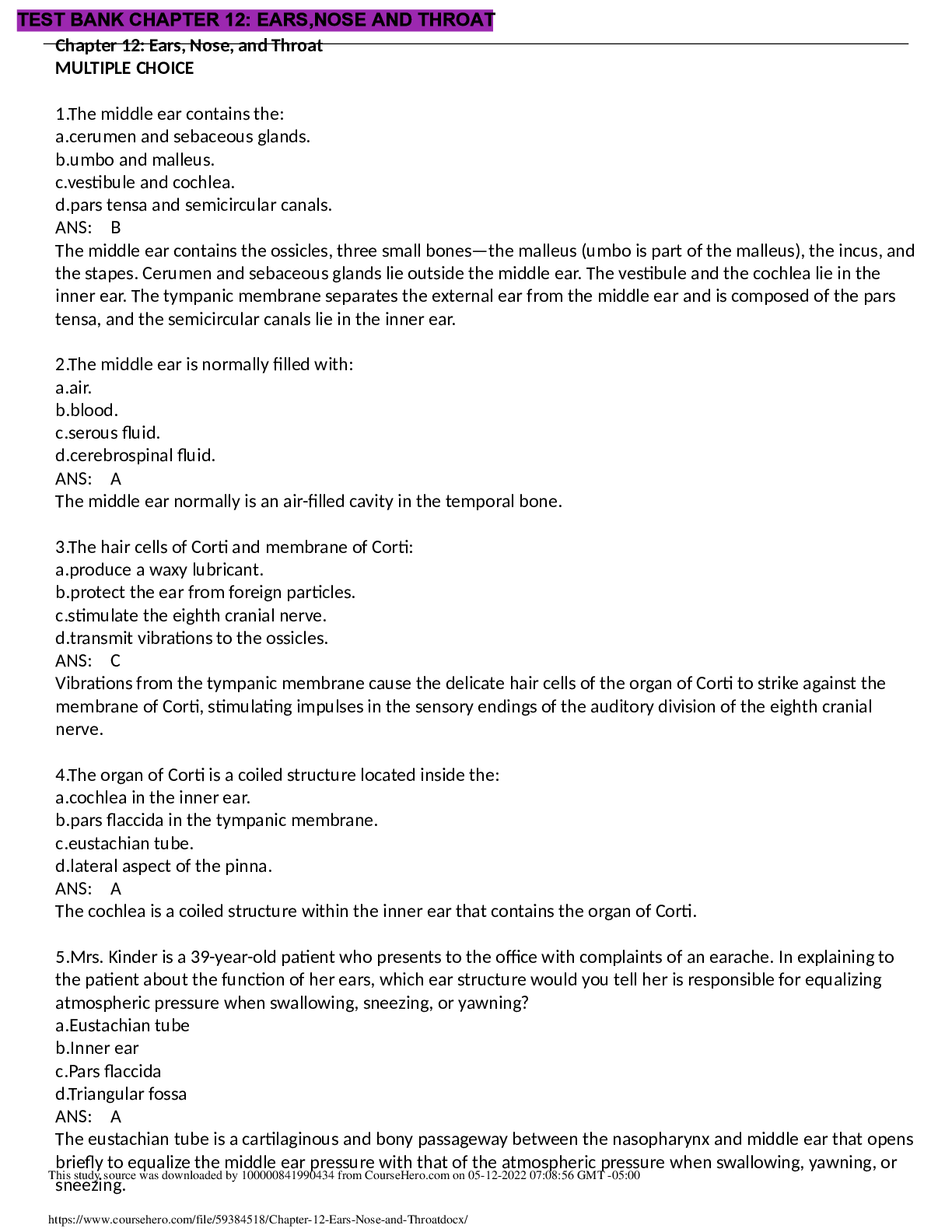
 (1).png)
_compressed.png)
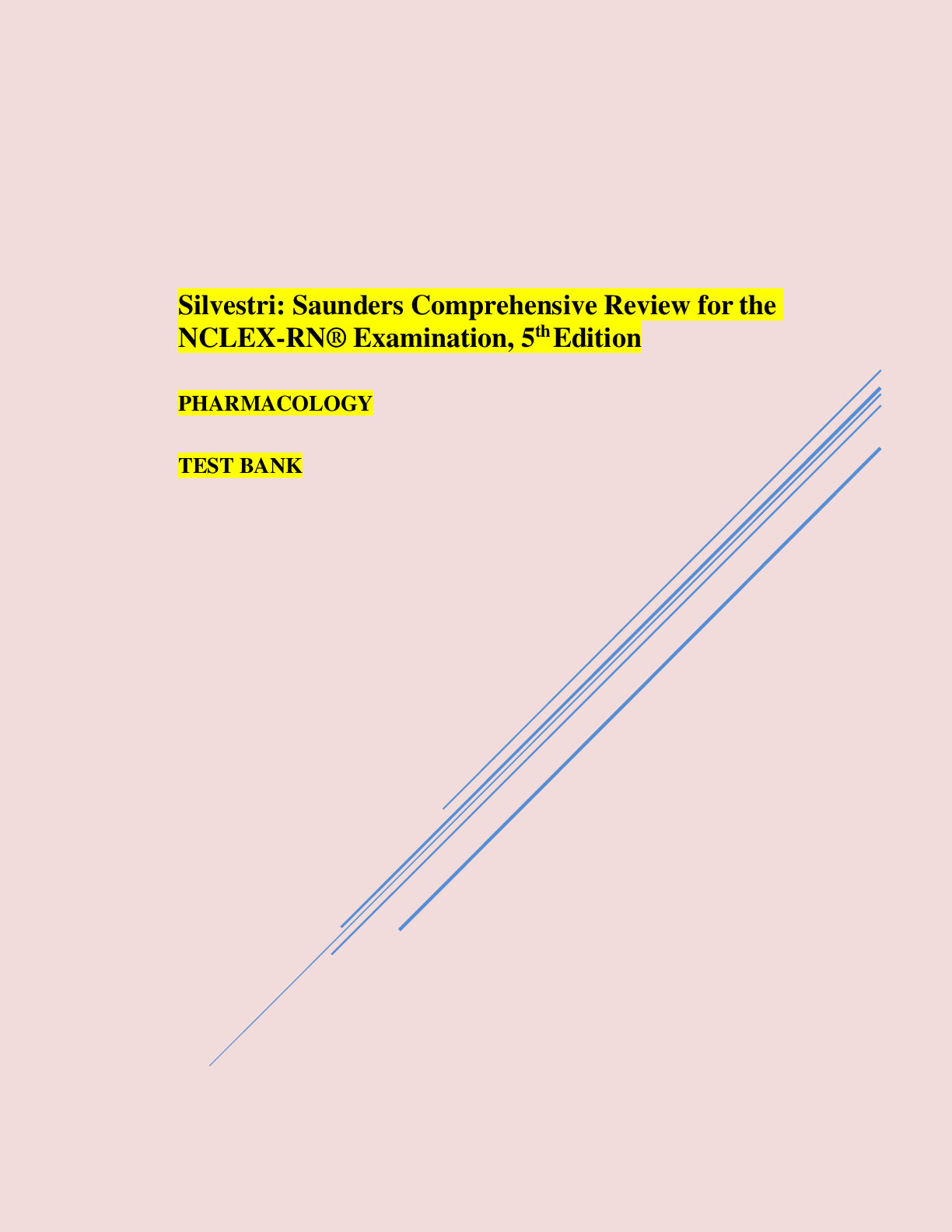

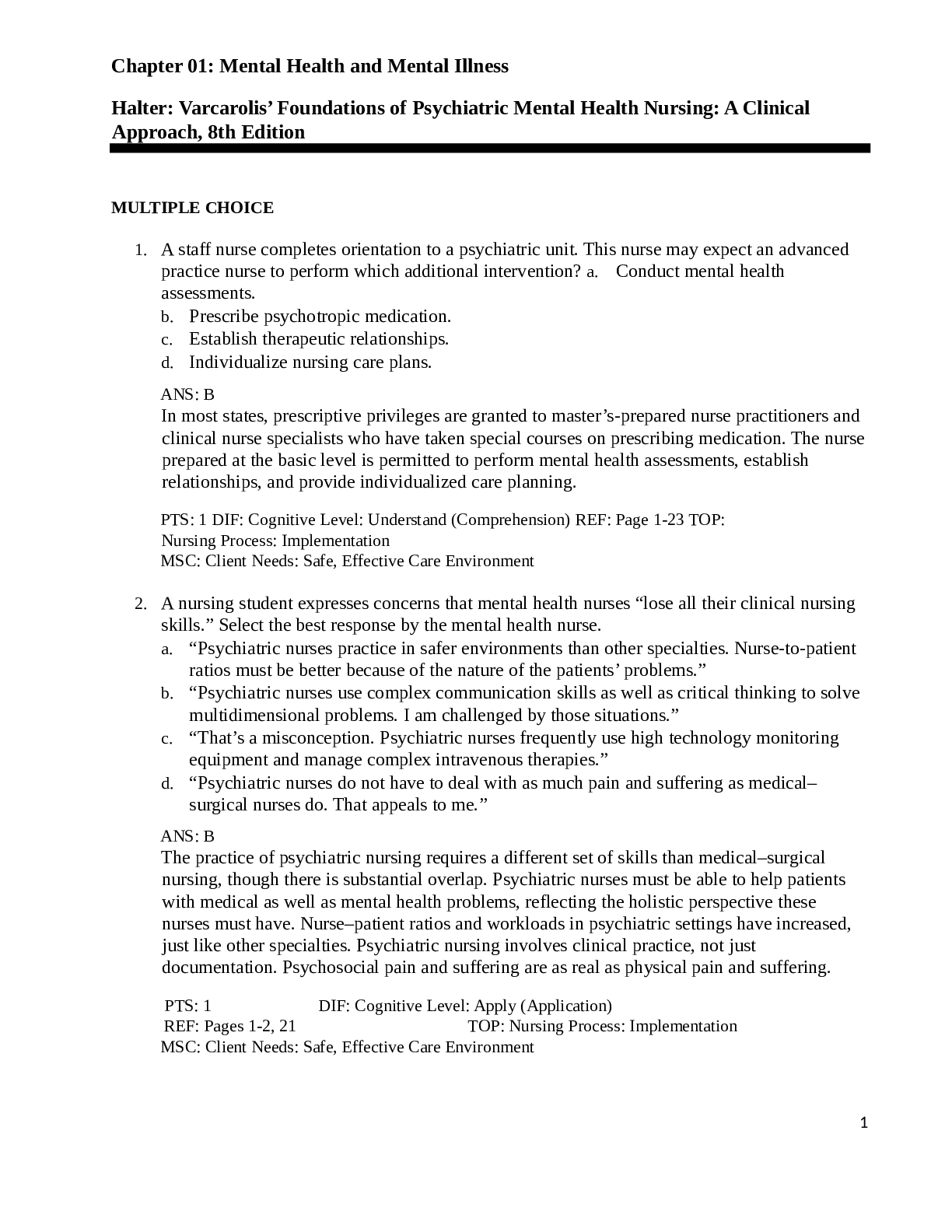
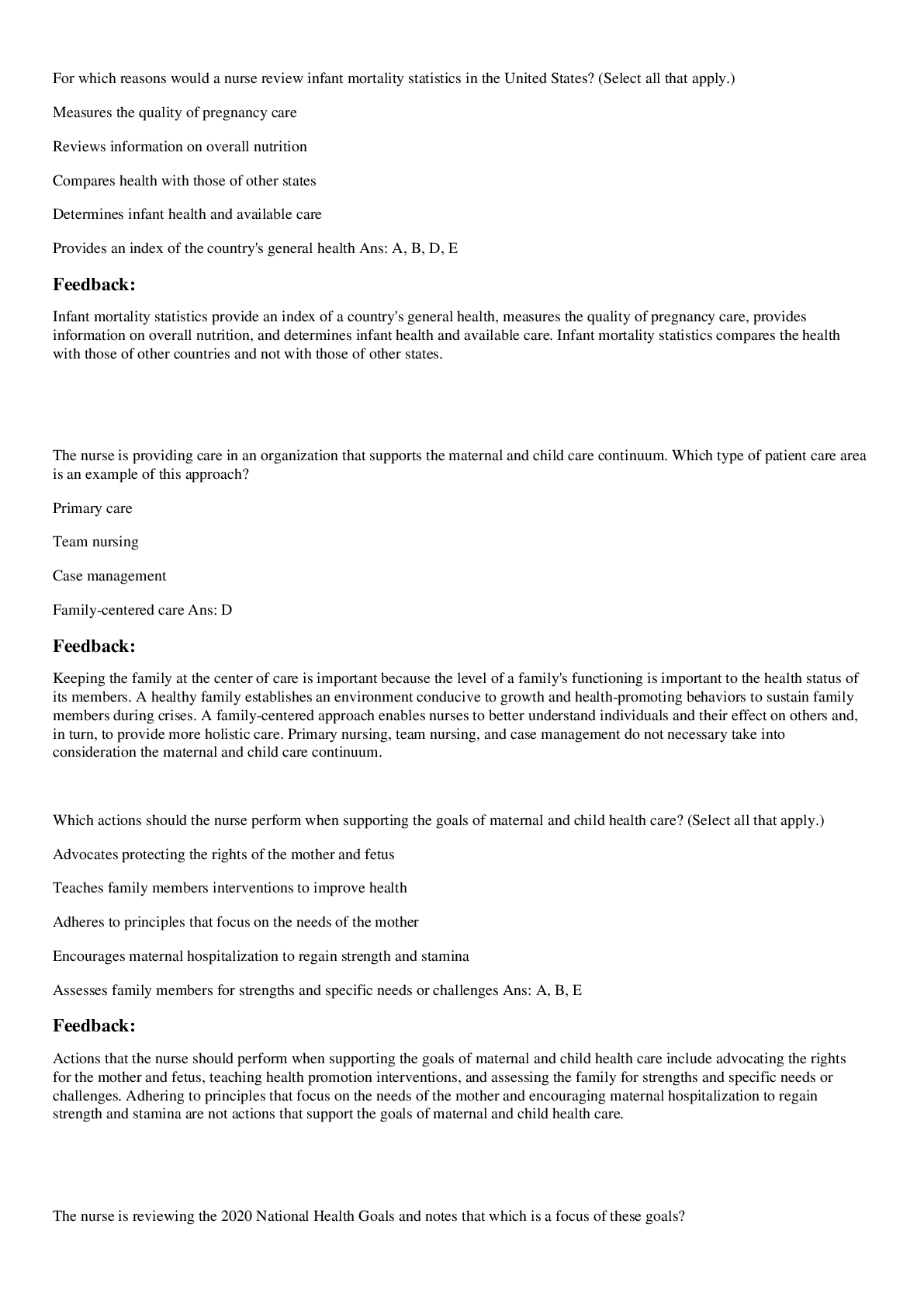
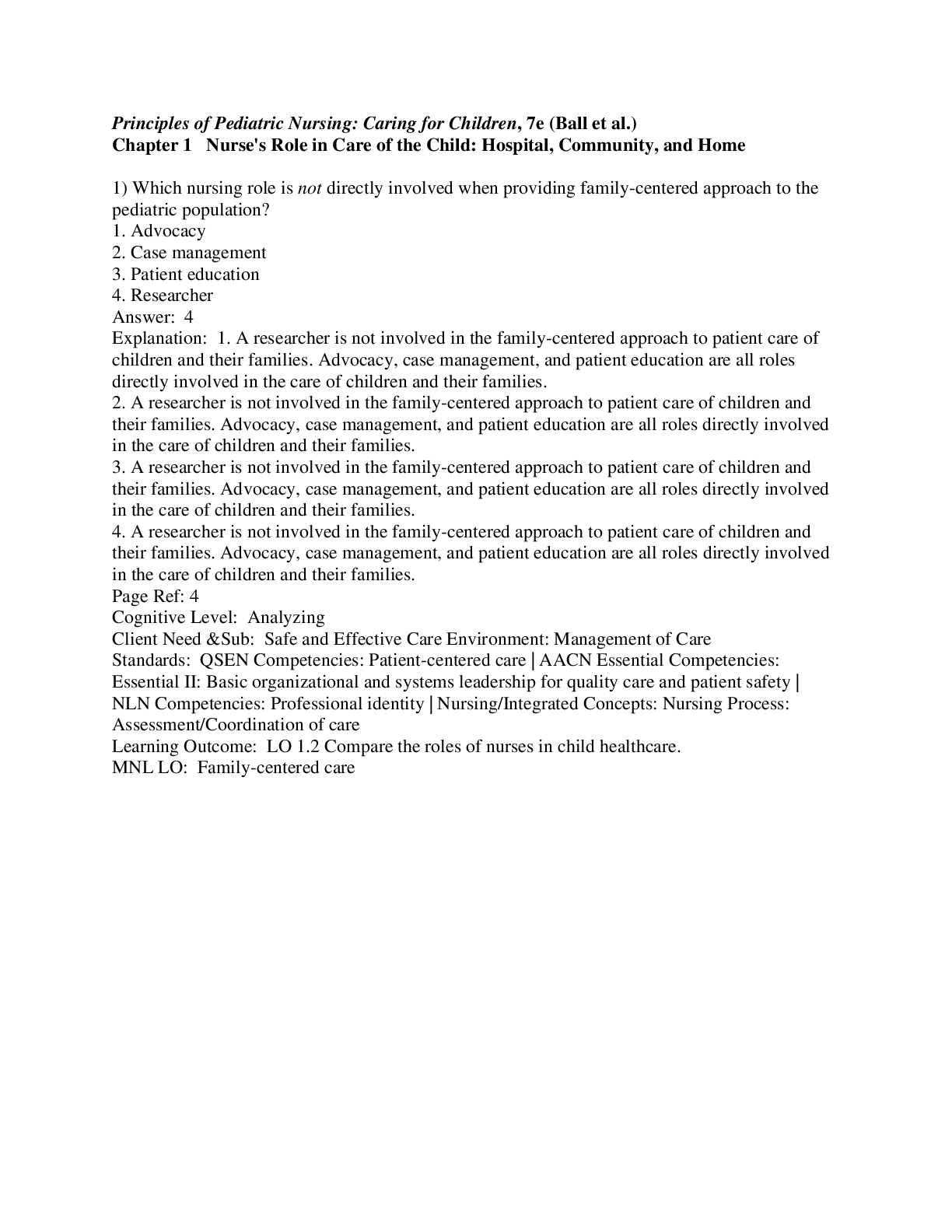
_compressed.png)
 (1).png)
